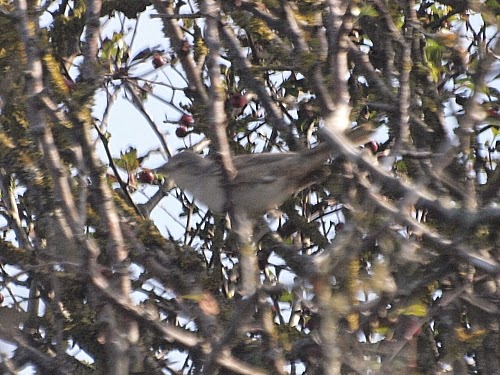A missed call from Bob Self along with news on the pager that the Barred Warbler had been seen again at Seaford Head (after a two day absence) seemed a reasonable alternative to further sites at Beachy and JK and I headed over, as much for a change of scenery as with any real expectation of seeing it. We arrived at Hope Gap to find some observers wandering off and the Barred Warbler not having been seen for an hour and a half. The area was very daunting but we had only been there 20 minutes when Bob saw it again further up the track. It had disappeared again, something it was making a habit of much to Bob's consternation. Knowing it was likely to still be in the immediate area a bit of playback was tried and it came in to investigate giving good views by the path. Also on Seaford Head we saw 29 Little Egrets, a Brent Goose on the sea, 2 Buzzards, 35 Swallows, Yellow Wagtail in a sheep field, Reed Warbler, 3 Blackcaps and 5 Chiffchaffs.
 |
| Barred Warbler in Hope Gap showing pale covert edges. A very nice find for Bob Self and my first in Sussex for nine years |
 |
 |
| indistinctly barred flanks just about discernible in this image as is the pale iris |
 |
| darker edges to undertail coverts evident in this image |
 |
| in Spotted Flycatcher pose |
 |
| paler edges to coverts and indistinct barring on the flanks just about visible |
 |
| Barred Warblers in Britain are normally expected to be disoriented juveniles but the pale eye suggests otherwise for this individual |
 |
| Brent Goose on the sea off Hope Gap, Winter is coming |
 |
| Comma taking advantage of an Indian summer |
 |
| Birling Gap and Belle Tout from above Seaford Head cottages |
 |
| cliff-fall central yet there always seems to be someone (barely visible in this image) that stands close to the edge |
A high tide walk around the Adur with Megan produced 8 Little Egrets, 3 Oystercatchers, 2 Greenshank and 45 Redshank on the saltings by the houseboats, 49 Turnstones roosting on boats by the Norfolk Bridge, 2 Kingfishers, 30 Swallows (flying east) and a Chiffchaff. A nice end to an enjoyable day.




























%2BP8315642.JPG)



































